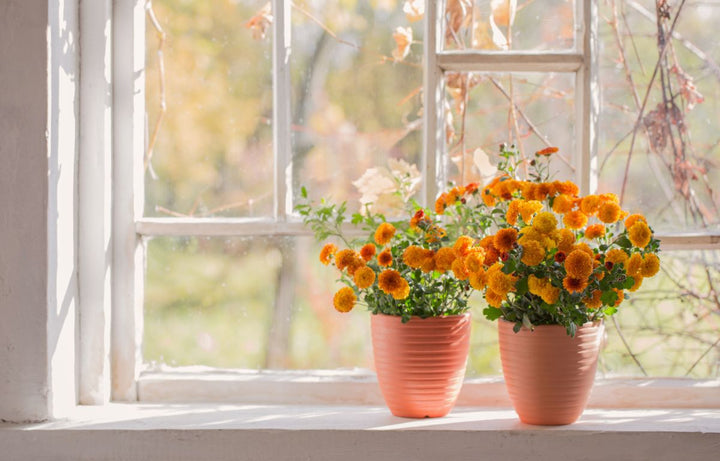
Chrysanthemums: A Blooming Delight for Warmer Seasons
Chrysanthemums: A Blooming Delight for Warmer Seasons
As the warm embrace of spring and summer envelops our world, there's nothing quite like the sight of vibrant Chrysanthemums to brighten up our potted gardens and indoor spaces. These stunning, completely edible flowers also known as "mums," have gained immense popularity for their exquisite beauty, versatility, and longevity. Best of all, they positively thrive in exposed, sun-drenched locations.

Chrysanthemums
Native to China, Chrysanthemums have been cultivated for over 2,500 years and are regarded as a symbol of longevity and immortality. This is due to their relatively long blooming season, often extending well into late autumn when other summer flowers have died back, ensuring your outdoor and interior living spaces remain lively and colourful for months on end.
The most common type of Chrysanthemum is the Chrysanthemum x Morifolium or Standard Chrysanthemum. This hybrid plant is bred for its variety of dazzling colours, shapes and sizes. Their vibrant petals range from cheerful yellows and pinks to rich reds and purples and can grow anywhere between 15-30cm in height and up to a meter in width if you let it.
Purchasing Flowering Plants
-
When choosing an established Chrysanthemum, examine the entire plant for signs
of health. Look for sturdy stems, vibrant green leaves, and no visible
damage, wilting, or yellowing.
-
Preference plants that have well-formed flower buds but have not yet started
blooming. This indicates that they have the potential for a longer blooming
period.
- If possible, check the roots. Healthy roots should be white or light tan, firm, and not overly crowded or pot-bound. Avoid plants with mushy or rotting roots.
Direct Sunlight and Warm Weather Tolerant
-
Reduced water loss: Chrysanthemums possess protective
pigments and a waxy leaf coating that reduces water loss via transpiration
to maintain hydration in dryer conditions.
- Tracking the sun: Their ability to move their flowers and leaves to track the sun's path, known as heliotropism, optimises energy absorption while preventing overheating. These adaptations enable Chrysanthemums to thrive in the intense sunlight of summer.

Suitability for Pots, Indoors and Outdoors
-
Container Gardening: Chrysanthemums are well-suited for pot
culture. They can be grown in containers both indoors and outdoors, making
them perfect for those with limited garden space. Simply choose a
well-draining pot and provide ample sunlight.
- Indoor Charm: While Chrysanthemums love the sun, they can also thrive indoors if given bright, indirect light. Their compact size and diverse colours are sure to add a pop of interest to your living spaces.
Caring for Chrysanthemums
-
Sunlight: Chrysanthemums thrive in full sunlight which
boosts foliage growth and flower production, so ensure they receive at least
6-8 hours of direct sun each day.
-
Well-Draining Soil: Use well-draining soil to prevent
waterlogged roots, which can cause root rot. A mix of potting soil and
perlite works well for container-grown mums.
-
Watering: Keep the soil evenly moist but avoid
overwatering. Water the plants at the base to prevent splashing water on the
leaves, which can lead to diseases and even burning during the day. More
established Chrysanthemums can withstand short periods of drought but young
ones must be watered regularly.
-
Pruning: Regularly pinch back or prune, young Chrysanthemum
plants when they are about 10 cm tall and repeat every few weeks until early
summer. This promotes lateral and bushier foliage growth and more abundant
flowering.
-
Deadheading: Remove spent blooms promptly to encourage
continuous flowering. This also helps divert energy towards producing new
buds and keeps the plant looking lovely and healthy.
-
Propagation: To propagate a Chrysanthemum, take stem cuttings from a healthy plant in
the spring. Remove lower leaves, dip in rooting hormone, and plant in
well-draining soil or a propagation medium. Keep moist until rooted.
- Fertilisation: Chrysanthemums readily absorb nutrients from the soil, especially during their growing season. Apply a balanced, slow-release fertiliser in the spring and early summer to promote healthy and abundant growth. However, be careful not to over-fertilise as the weather becomes cooler as this can stimulate foliage growth at the expense of flowers.

Problems and Solutions
-
Late Summer Pruning: To prevent leggy growth and prepare
them for winter, prune your Chrysanthemums back by one-third in late
summer.
-
Overwintering: Protect your potted Chrysanthemums in colder
regions by moving them to a sheltered area or covering them with mulch to
insulate against frost if kept outdoors.
-
Insects and Pests: Monitor for common indoor pests like
aphids and spider mites; use insecticidal soap or neem oil as a natural
remedy. Maintain good air circulation to prevent fungal diseases.
-
Low Sunlight: Signs your Chrysanthemums are not getting
enough sunlight during the day include stunted and leggy growth, wilting and
yellowing leaves, slow or inactive flowering, and leaf and flower drop. Move
your plants to a sunnier position or incorporate fluorescent UV grow lights
to boost photosynthesis production.
- Overcrowding: Fertilise with a balanced, slow-release fertiliser in the spring and early summer to encourage flowering. Check for overcrowding, as Chrysanthemums may need to be divided if they become too crowded.
Chrysanthemums are true stars of the warmer seasons, gracing our gardens and homes with their radiant beauty. Their adaptability to pots, indoors, and outdoor spaces, coupled with proper care and maintenance, ensures a colourful and thriving display from spring through to autumn. So, whether you're a seasoned gardener or a beginner, consider adding Chrysanthemums to your horticultural repertoire for a blooming delight that will brighten your days and nights throughout the sunny seasons.
